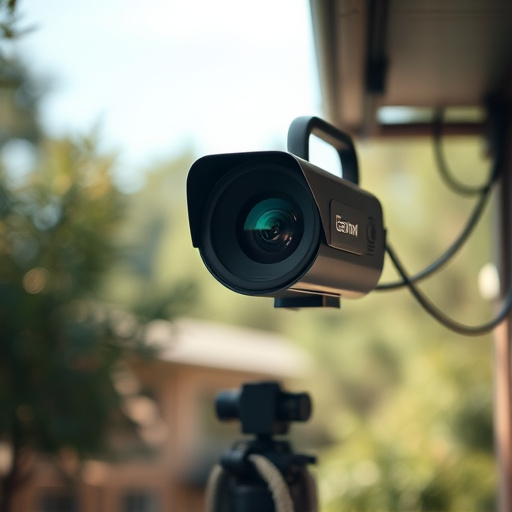Wireless hidden cameras have transformed apartment security, providing landlords with discreet surveillance solutions that eliminate complex wiring. These devices, disguised as everyday objects like smoke detectors or power outlets, offer remote monitoring via smartphones or computers, enabling deterrence of intruders, identification of property issues, and maintenance of a professional environment. Property managers strategically place these cameras at entry points, common areas, and interior spaces to enhance security and deter illegal activities. The use of wireless hidden cameras raises ethical considerations regarding tenant privacy rights, requiring navigation of legal frameworks like the Video Surveillance Device Act for compliance. In today's digital age, these advanced tools offer landlords unparalleled peace of mind, enabling remote monitoring, evidence collection, and protection against property damage and criminal activities.
Uncover the often-hidden world of surveillance with our guide to wireless hidden cameras in rental properties. We explore how these discreet security solutions can enhance safety while navigating legal and ethical boundaries. From understanding advanced technology to identifying common placement strategies, this article equips you with knowledge on optimizing surveillance without invading privacy. Discover best practices for installing wireless hidden cameras in apartments, ensuring a secure environment for all.
- Understanding Wireless Hidden Cameras: A Discreet Security Solution for Apartments
- Common Placement Strategies for Optimizing Surveillance in Rental Properties
- Legal Considerations and Ethical Boundaries: Navigating Privacy Concerns
- Advanced Technology and Detection Methods: Staying Ahead of the Game
Understanding Wireless Hidden Cameras: A Discreet Security Solution for Apartments
Wireless hidden cameras have emerged as a discreet and effective security solution for apartments, offering landlords and tenants alike enhanced peace of mind. These innovative devices are designed to blend seamlessly into their surroundings, often resembling everyday objects like smoke detectors or power outlets, making them nearly impossible to detect by untrained eyes. Their wireless nature eliminates the need for complex wiring, allowing for easy installation and remote monitoring from a smartphone or computer.
This technology provides a robust surveillance system that can deter potential intruders, assist in identifying issues within the property, and even serve as evidence in case of security breaches. With real-time alerts and high-definition video footage, apartment owners can remotely assess their properties, ensuring the safety and well-being of tenants while maintaining a professional and confidential environment.
Common Placement Strategies for Optimizing Surveillance in Rental Properties
In optimizing surveillance in rental properties, property managers often employ strategic placement of wireless hidden cameras for apartments to ensure maximum coverage. Common locations include entry and exit points, such as front doors, back gates, and garage openings, where unauthorized access can be easily detected. Additionally, common areas like lobbies, hallways, and stairwells are crucial monitoring zones due to their high traffic and potential for security breaches.
Another strategic area is the interior of rental units themselves. Installing wireless hidden cameras in living rooms, kitchens, and bedrooms allows for discreet monitoring of tenant activities. This is particularly important for maintaining a safe environment and deterring any potential illegal activities within the premises. By utilizing these placement strategies, property managers can effectively utilize wireless hidden cameras for apartments to enhance overall security.
Legal Considerations and Ethical Boundaries: Navigating Privacy Concerns
In the realm of rental properties, the installation of wireless hidden cameras has become a controversial topic, raising important legal and ethical considerations regarding privacy. While landlords may have valid security concerns, particularly in managing maintenance or addressing issues like property damage or illegal activities, deploying such surveillance equipment requires careful navigation through existing laws and regulations. The use of hidden cameras in apartments without proper notice to tenants can infringe upon their right to privacy, as guaranteed by numerous legal frameworks globally.
As technology advances, these wireless hidden cameras become more accessible, prompting landlords to consider their options. It’s crucial for both parties to understand the boundaries set by laws like the Video Surveillance Device Act (or similar regional legislation). Landlords must ensure they comply with regulations regarding placement, notification, and access to recorded footage. Ethical boundaries should also guide the use of surveillance technology, promoting transparency, respect for tenant privacy, and a fair balance between security needs and individual liberties.
Advanced Technology and Detection Methods: Staying Ahead of the Game
In today’s digital era, advanced technology has made it easier than ever to employ wireless hidden cameras for apartments and other rental properties. Landlords and property managers are leveraging sophisticated surveillance tools that blend seamlessly into the environment, offering unparalleled peace of mind. These innovative devices range from tiny, unassuming cameras disguised as everyday objects like smoke detectors or light bulbs, to more advanced systems capable of detecting and transmitting high-quality video feeds in real time.
By staying ahead of the curve with these cutting-edge detection methods, landlords can prevent property damage, ensure tenant compliance, and deter potential criminal activities. Wireless hidden cameras for apartments provide a layer of security that goes beyond traditional means, allowing for remote monitoring and evidence collection. This proactive approach to surveillance empowers property owners to maintain control and protect their investments effectively.
In the pursuit of secure rental environments, understanding and utilizing wireless hidden cameras offers a discreet yet effective security solution. By employing advanced technology and staying informed about detection methods, landlords and property managers can optimize surveillance while navigating legal boundaries. Recognizing the importance of privacy concerns, responsible implementation of these measures ensures a harmonious balance between security and tenant rights, ultimately fostering a safe and peaceful living space for all.
